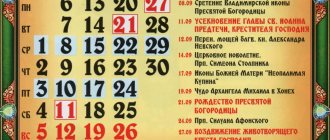Church New Year On September 14 (September 1, Old Style) the Church New Year begins - a new year in the liturgical circle. In liturgical books, the New Year is also designated by the ancient Slavic word - Leta. On this day, like January 1, in all Orthodox churches the priesthood serves a prayer service for the beginning of the New Year. Christians offer prayers of gratitude to God for the past year, for all the mercies sent to us by the Lord of Heaven, and ask for blessings for the coming year.
History of indict
The concept of indictment is associated with the Roman Empire. The word indict means to evaluate or pronounce.
The original meaning of the indictment was to announce the collection of a compulsory food tax in favor of the state. Later, this concept expanded and began to designate a certain time period during which the property of the population, the number of the population itself and the amount of taxes were assessed. At first, the indictment varied, ranging from 5-15 years, and depended on the will of the emperor. Emperor Octavian Augustus ordered that the date of his birth, September 23, be considered the beginning of the indict, and his successors also used this number as the beginning of the indict.
Emperor Constantine the Great
In 312/313, under Emperor Constantine, a fifteen-year period of indictment was adopted. Around 462, the start date of the indictment was moved to September 1st. Roman citizens initially called the years of indictment: the first, second, third year of indictment. Gradually, the meaning of the word changed, and the word indict began to be used, replacing the word year with it - the first indict, the second indict, etc.
For a long time, Roman cities did not have a common starting date for the New Year. In 537, Emperor Justinian I documented a single date - September 1.
history of the holiday
Emperor Constantine.
Mosaic above the entrance to Hagia Sophia. Photo: Commons.wikimedia.org In Russia until the 14th century, the year began in the spring. All ancient Russian chroniclers began the year on March 1. This tradition was established by Alexandrian scientists, according to whose calculations, God completed the creation of the world on Friday, the first of March, preceding Saturday, better known as the “day of rest.”
September 1 replaced the usual March 1 in Russia in 1363, and in the Roman Empire during the reign of Emperor Constantine the Great in 325 after the first Ecumenical Council was held in 325. The beginning of the year began to be considered the beginning of the indict (tax collection).
Calendar reckoning (numbering) by indicts or indictions was adopted in the Roman Empire back in the 6th century during the reign of Justinian I (527–565).
The New Year in Russia was celebrated on September 1 until the reign of Peter I, who in 1700 moved the beginning of the year to January 1. At the same time, the Church continues to consider September 1, according to the old style, as the beginning of the indict, that is, the church New Year - the first day of the seventh month from the creation of the world. After 1918, when Russia switched to the Gregorian calendar, the New Year falls on September 14.
Justinian I. Mosaic of the Church of San Vitale in Ravenna Photo: Commons.wikimedia.org
Seventh month
The date September 1st as the New Year was chosen, obviously, according to the Providence of God. In the Old Testament there is a command from God to celebrate the seventh month in a special way - Tishri (September), when the harvest is harvested. In the seventh month, Moses received the tablets of the Covenant from God, in the seventh month the construction of the Tabernacle in the camp of the Israelites began, the global flood ended, and the temple of Solomon was consecrated. It was in the seventh month that the high priest entered the Holy of Holies only once a year.
According to Biblical chronology, March is the first month from the creation of the world, respectively, September is the seventh.
Great Indiction
Indiction is sometimes called indiction, but it should not be confused with the concept of great indiction. This is the great peace (Easter) circle - a period of time of 532 years, during which the date of Easter celebration occupies all possible positions. After these 532 years, the dates on which Christ's Resurrection falls are repeated. The Great Indiction is a combination of the lunisolar and solar cycles.
Paschalia
The Great Indiction is counted from the day of the creation of the world - March 1, 5508 BC. Since then, 14 Great Indictions have passed. The current one, the fifteenth, began in 1941.
INDICTION GREAT
[great (peaceful) circle], Russian. the name of the complete Easter cycle of 532 years. It is also known under the isopsephic name BLCB (the sum of the numerical values of these letters is 532). After the end of I.V., which is a combination of the 19-year “lunar” (more precisely, lunisolar) and 28-year “solar” (more precisely, weekly-leap) cycles, the date of Christ. Easter calculated according to the Julian calendar and the Orthodox calendar. Easter eggs are repeated in the same order. Compiling a table for 532 years actually means creating an “eternal” Easter. However, such a table is very cumbersome. More popular were Easter holidays, which did not cover the entire I.V., but only 95 years (a 5-fold 19-year cycle, after which amendments related to leap years are required). According to the Easter Chronicle, some illiterate Christians mistakenly considered the 95-year tables to be cyclical and incorrectly calculated the full moons, “serving as a laughing stock to Jews, pagans and heretics” (Chron. Pasch. P. 19-20). One of these tables, attributed to St. Cyril of Alexandria and covering the years 437-531, continued Dionysius the Lesser, shifting the point of reference from the era of Diocletian to “the years of our Lord Jesus Christ” and putting it thus. the beginning of modern chronology. Complete 532-year tables of I.V. based on different types of the 19-year lunar-solar cycle were compiled by Annian of Alexandria (c. 400; 172 BC - 360 AD), Victoria of Aquitaine (c. 457; at 28-560), Eas of Alexandria (c. 562; at 553-1084), Ananias Shirakatsi (in 667; at 553-1084), Bede the Venerable (in 725; at 532-1063), etc. The numbering of years in such tables sometimes formed the basis of chronology systems (for example, the years of the Paschal of Ananias correspond to the “great” Armenian era, and the Paschal of Bede corresponds to the era of Dionysius). Rus. tables of the complete, 532-year-old Paschal have been preserved since the 14th century. (the oldest RKP.: GIM. Syn. No. 325. L. 192 vol. - Romanova. 2002. P. 67-70), although the “great circle” was already well known to Kirik Novgorod in the 12th century. (Simonov R. A. Mathematical and calendar-astronomical thought of Dr. Rus'. M., 2007. P. 323). Most Easter calculations were made in the Middle Ages using quick reference tables (“wheels”, “circles”, “hands”, etc.).
Already in the 4th century, at the stage of the formation of chronology systems from the Creation of the world, an idea was formed about the connection of I. V. with the beginning of creation (from where the other Russian name I. V. - “peaceful circle”) was formed. Both Alexandrian (from 5492 BC) and Byzantine. (from 5508 BC) the era from the Creation of the world begins with the 1st year of I.V. of the corresponding type. In addition, eschatological expectations based on the idea of the cyclical nature of the universe were also associated with I.V. According to one of the “astronomical” theories, the total existence of the world should have been 12 “time periods”, or 6384 years (Dobschütz E., von. Coislinianus 296 // BZ. 1903. Bd. 12. S. 550-551). The prosperous beginning of the 13th I.V. (Sept. 1, 876 according to the Byzantine era) moved the estimated date of the end of the world to 7000 (1492 A.D.), which, according to the ancient millenarian tradition, rooted in the pre-Christian era , was supposed to mark the end of the last, 7th 1000-year “day of the Lord.” In this regard, Easterists did not dare to compose Easter for the 14th I.V., which began on September. 1408, tremblingly awaiting the mystical date. Only after Sept. 1492, the Savior’s words about the vanity of human attempts to measure “the times or periods which the Father has set in His power” (Acts 1.7) were once again confirmed; Easter Sundays again became widespread (often in a truncated form, from 85 to 7001 from the Creation of the world). At the same time, the idea of a “great circle” of world history was revived, this time in the form of a complete combination of the 19-year “lunar” and 28-year “solar” cycles with a 15-year period of indictments. A huge table for 7980 (taking into account the addition - for 8000) years, included in the collection. “The Peaceful Circle” (XVI century) became a major achievement of Russian. Paschalistics, incorporating the past and immediate future of humanity into the fabric of liturgical time. At the same time, the editor of the collection, Novgorod priest. Agathon reminded readers that determining the date of the end of the world is under the jurisdiction of God and we “are not aware of the end of the world” (Romanova. 2002. pp. 187-188. Ill. 22-23). Currently The time for Orthodox Easter is the 15th I.V., which began on September 1. (old style) 1940 To the Gregorian calendar and Western calendar. Easter I.V. does not apply.
Lit.: Krusch B. Studien zur christlich-mittelalterlichen Chronologie: Die Entstehung unserer heutige Zeitrechnung. B., 1938; Bedae Opera de temporibus / Ed. Ch. W. Jones. Camb. (Mass.), 1943; Grumel V. La Chronologie. P., 1958; Romanova A. A. Peaceful circle // SKKDR. Vol. 3. Part 2. pp. 198-201; she is the same. Old Russian calendar and chronological sources of the XV-XVII centuries. St. Petersburg, 2002.
P. V. Kuzenkov
Church New Year
In the Church, the celebration of the New Year on the first day of September was approved at the first Ecumenical Council, held in Nicaea in 325. The celebration was established in honor of the victory of Emperor Constantine over Licinius, who ruled in the East and continued the persecution of Christians. The participants of the Council decided to specially celebrate this day as a sign of gratitude to Constantine the Great for the liberation of Christians from persecution.
New Year in Russia
In Russia, the church New Year of the year did not coincide with the civil New Year, which was celebrated in the spring. In 1492, one date for celebration was established - September 1. The New Year was celebrated very solemnly, the holiday was led by the Tsar and the Patriarch. Under Peter I, the civil New Year was moved to January 1.
What is the Great Indiction?
The concept of indiction is associated with such a concept as the Great Indiction or the Peaceful Circle. The Great Indiction is a long period of time of 532 years that defines the Easter cycle and is the basis of the church calendar.
The church calendar followed by the Jerusalem, Russian, Georgian, Serbian Local Churches and monasteries of Athos is based on the Byzantine calendar, which developed by the 6th century.
Monasteries of Athos. Photo: Commons.wikimedia.org
Question answer
Calendar of religious holidays for 2014 A feature of the Byzantine calendar is that it is inseparable from Easter. This calendar begins the year on March 1 and keeps a continuous count of days from Friday, March 1, 5508 until the birth of Christ.
The rules for calculating the day of Easter developed during the 2nd–5th centuries AD. In the Alexandrian Easter, March 21 of the Julian calendar is called the vernal equinox. The conventional calendar full moon falling on March 21 or subsequent days is called the spring Easter full moon. The Sunday after the spring full moon is the bright holiday of the Resurrection of Christ. The date of Easter can range from April 4 (March 22) to May 8 (April 25).
Gospel at the beginning of the Indict
On the day of the New Year, the Church preaches the Holy Gospel, namely a small passage from the Holy Evangelist Luke (Luke: 4: 16-22). From this reading it becomes absolutely clear that the Lord, as it were, got up and began a new work - preaching, in fact, began a new life. He publicly says about himself: “The Spirit of the Lord is upon me; For He has anointed me to preach good news to the poor, and He has sent me to heal the brokenhearted, to preach release to the captives, recovering of sight to the blind, to set at liberty those who are oppressed, to preach the acceptable year of the Lord.”
Lord Jesus Christ
The word “summer” can be interpreted not as a year, but as a new life - to preach a new favorable life.
In the Gospel reading at the beginning of the Indict, the Byzantines saw a direct order from God to celebrate this day as the beginning of a new year. This is stated in the Minology of Basil 2: “From that time on, He gave us Christians this holy holiday.”
The spiritual meaning of the holiday
According to Theophan the Recluse’s interpretation of the Gospel passage read on the day of the Indict, the Lord not only preached favorable Summer, He brought it. Summer is favorable, new life is in the souls of people. There will never be heaven on earth, earth is a place of preparation for heavenly life, the beginning of heaven is in the soul. The Lord gives us the grace to change our souls and acquire a peaceful spirit. He who listens to the Lord, lives according to His commandments, and sincerely tries to serve God, receives grace from Him and through its power feels a pleasant summer within himself. We cannot fill our soul with this pleasantness with our thoughts, it is given by God, and for this we need to work, and peace and tranquility will settle in the soul. There may be no peace externally, only internal, from God. However, when peace settles inside, external sorrows no longer burden you, you don’t feel them.
Divine service on New Year's Day
On September 1, the Church honors the memory of Saint Simeon the Stylite, his mother Martha and the fasting virgins with the martyr Ammun the deacon, their teacher. Therefore, the service on this day combines 3 services. At Great Vespers, an excerpt from the book of the prophet Isaiah is read, because on this day the Church remembers how Jesus Christ entered the temple and read this passage to those gathered.
Prayer service for the New Year
Stichera for the holiday were composed at different times by church hymn-makers John the Monk, Herman, and Andrei Pirsky. The canon of the holiday was written by Saint John of Damascus in the 8th century. The apostolic reading for the day contains teaching about the need to pray for government authorities (regardless of what they are). The Apostle Paul explains the need for prayer for rulers: “that we may live a quiet and quiet life in all godliness and purity.”
Let us be guided by this apostolic admonition: the apostle affirms that “This is good and acceptable in the sight of God our Savior.”
Orthodox calendar. Start of indict
Celebration traditions
Boris Godunov Photo: Commons.wikimedia.org
On this day, the main celebration took place on Cathedral Square of the Moscow Kremlin, where a platform was built from which the Metropolitan and Grand Duke announced the end of the year and congratulated the people. The Metropolitan blessed the water and sprinkled it on the prince and the townspeople standing around, and everyone congratulated each other. In the New Year, it was customary to present the heir to the throne to the people for the first time when he reached adulthood (14 years old). The future prince gave a public speech from the platform.
It was on the New Year of 1598 that Boris Godunov .
Indict (from the Latin word “indictio” - assignment, tax, tax) is a unit of historical time. During the time of Emperor Constantine the Great, the indict was established as the official measure of the year, due to the practicality of such calculation.
Indiction - a 15-year period of time, after which the Roman emperors made a new order on the distribution of taxes.










